For those who have never heard of GAME: the acronym stands for Global Approach by Modular Experiments, an internationally oriented research and training program in marine ecology that is in existence for over two decades now. Every year, young researchers from around the world – from Finland to Malaysia, from Japan to Chile – work together on a common research question. Identical experiments are conducted at eight different locations so that the results, which are obtained within six months, can be compared across latitudes, climatic conditions, and biogeographical zones.
In a time that confronts us with global environmental crises, such as climate change and the massive loss of biodiversity, we need precisely such large-scale, coordinated research approaches. Because only by understanding how the reaction of ecological processes to anthropogenic pressures is shaped by environmental conditions, we can make well-founded statements about their stability, vulnerability, or adaptability – and ultimately develop better conservation measures.
And who is GAME 2025? We are 16 master’s students from various countries—Japan, Malaysia, the Philippines, Cape Verde, Wales, Finland, Chile, and Germany—who, after a one-month long preparation course at GEOMAR in Kiel travelled in teams of two persons to eight countries to collect data. Everything is coordinated by Mark Lenz. Since 2004, the Kiel native has been the scientific coordinator of the international research and training program GAME at GEOMAR.
And who are we?
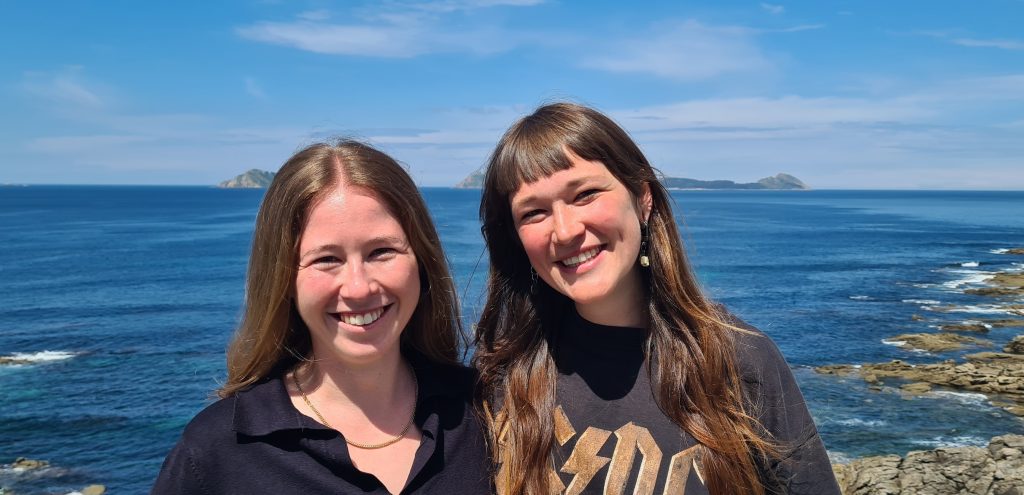
Hola from Spain!
Anna [27] from Osnabrück and Verena [27] from Potsdam are Team Spain 2025.
Anna
I began my biological career in Osnabrück with a Bachelor’s degree in Biosciences. I continued within the Master’s program, “From Molecule to Organism,” also in Osnabrück. During my studies, I had the opportunity to explore many different fields and build a broad knowledge base. Two marine biology excursions, in particular, captured my enthusiasm: one to the Biologische Anstalt Helgoland, and another to the Station Biologique de Roscoff on France’s north-western coast. Working in marine biology was so rewarding that I wanted to write my master’s thesis in this field. Since there is unfortunately no sea in Osnabrück, I looked for alternatives and discovered GAME. What fascinates me about the program is its global character and excellent training, which prepares you for a career in science—on top of that, the research topic of 2025 itself is truly captivating.
Verena
Originally, I come from the southwest, from the beautiful and most sunny place in Germany – Freiburg – but started studying biology in Tübingen. For my Bachelor thesis, I already worked with aquatic organisms and investigated the behaviour and personalities of weakly-electric fish (Apteronotus leporhynchus). After the time in the south of Germany, I wanted a change. Change in place and change in study and this brought me to Potsdam and to Geoecology. Through my studies, I already had a lot to do with global concepts and that was one of the reasons why I wanted to be part in an international program like GAME.
And now? We are in Spain. More precisely….
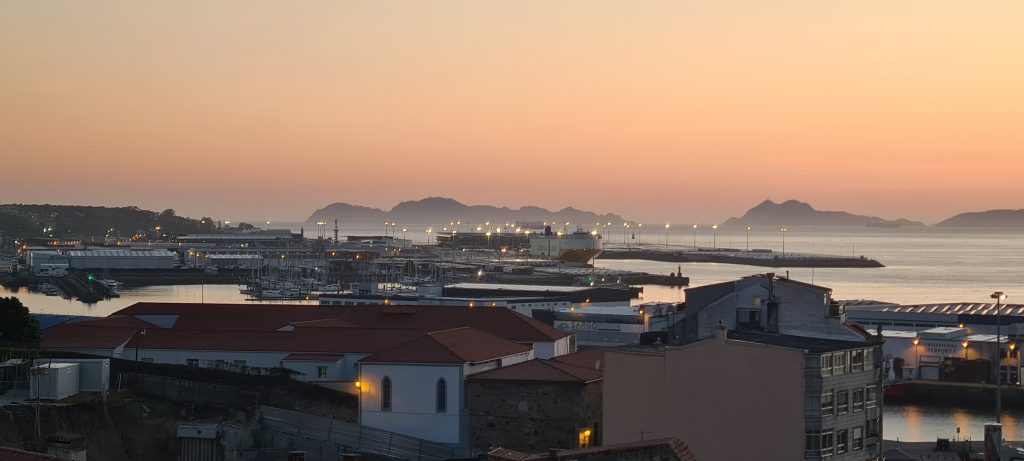
…in Vigo. For many, it may be just a tiny dot on the map in the far northwest of Spain—if they even know it at all. Nestled between dense pine forests, the rough Atlantic Ocean, an impressive mountain backdrop, and a view on the Cíes Islands (part of the Islas Atlántica de Galicia National Park), Vigo will be our new home and workplace for the next six months.
The name might suggests that Vigo is a small town. The name comes from the Latin vicus spacorum, it means “small village.” However, it is the largest city in Galicia, located in northwest Spain on the Ría de Vigo, a bay that extends 15 km inland to Arcade (Santiago).
The proximity to the Atlantic Ocean and the surrounding mountains not only offers a breathtaking panorama, which can be admired from many viewpoints (Mirador) in and around Vigo, but also means that this region is blessed with very high rainfall. Vigo records an annual rainfall of 1787 mm, compared to only 750 mm in Kiel.
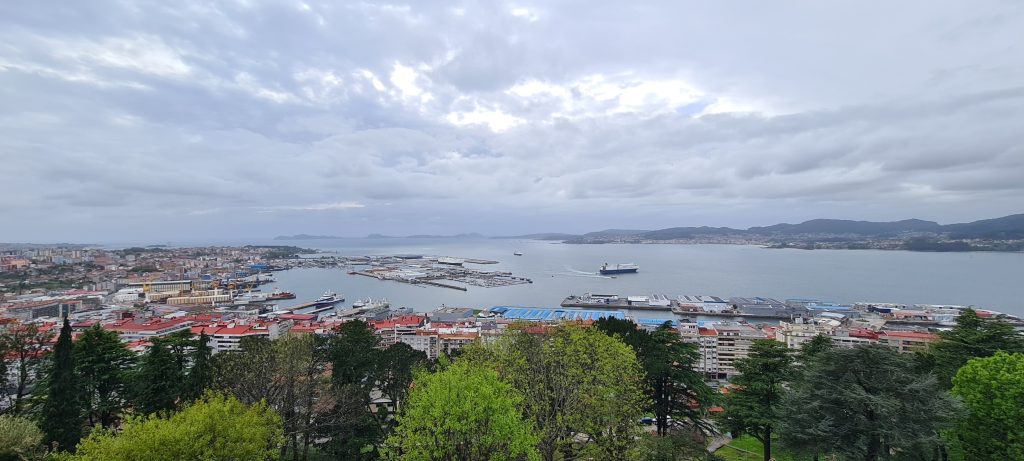
Due to the city’s hilly location, numerous escalators and elevators make everyday life and our initial exploration of the city easier.
One of our first destinations was the Monte O Castro fortress, which towers 130 meters above Vigo and offered us a first magnificent view of the city, the other shore, and the offshore islands.
On the way back to the harbour, we passed through the old town, among other places. Numerous restaurants, taverns, and tapas bars invite you to sample the many delicacies of the region. Vigo is particularly known for its seafood, especially oysters, which are cultivated in the numerous oyster farms in the bay. The wide Rua do Príncipe, which is perfect for a shopping trip, leads to the waterfront promenade. But we’re not the only ones who’ll be heading for the main shopping street. Another thing we quickly noticed: Every day, many pilgrims walk through the city on their way to Santiago de Compostela. The end point of the Way of St. James is only about 80 km from our port city. A destination that’s definitely on our bucket list.
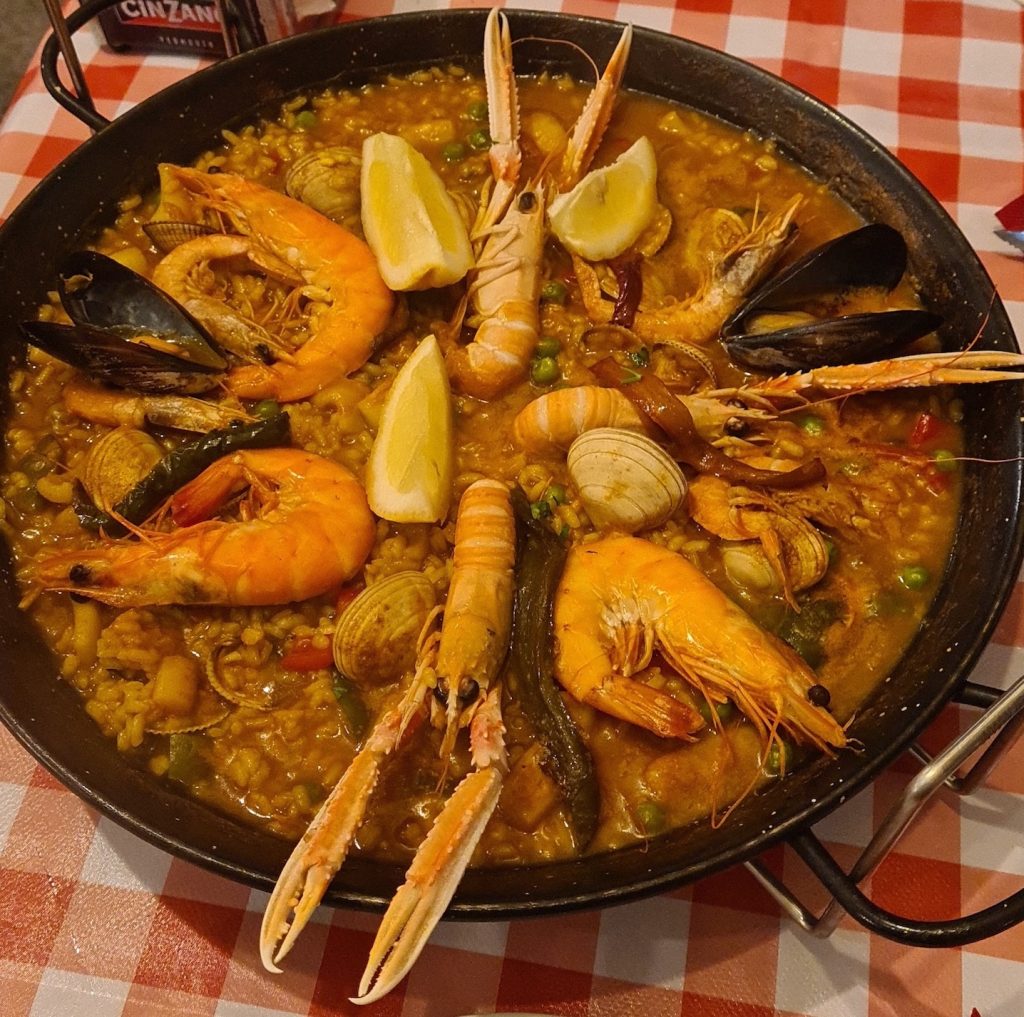
Down at the port, instead of beaches and sand, there are numerous ships to admire. From cruise ships to industrial vessels to yachts, there is something for every ship enthusiast. Vigo’s harbours have not only a Mediterranean flair but also a strong industrial port city character.
In a few weeks, one of these ports, in the Bouzas district, will host our field experiment.
But first, we headed west, about 20 minutes from the center, along the coast, past beautiful beaches and scenery, to the Centro Oceanográfico de Vigo.
There, we were warmly welcomed by our two team supervisors, Eva Cacabelos and Paplo Otero. First on the agenda, of course, was a tour of the institute – beautifully situated, right on the rugged Atlantic coast. Up on the roof terrace, with coffee in hand and a sea breeze around us, we turned to the real reason for our stay: our master’s thesis and this year’s GAME project, which is themed “ALAN.” You’ll find out exactly what’s behind it and what initial difficulties we encountered in a moment.
But first, a moment to take it all in and enjoying the view of the Cíes Islands.
Before the hustle and bustle of summer begins, we should definitely take the ferry across and ideally camp there for a night. Not only do the paradisiacal beaches and crystal-clear water attract hundreds of visitors every year, the nature reserve also serves as a refuge for countless bird species.
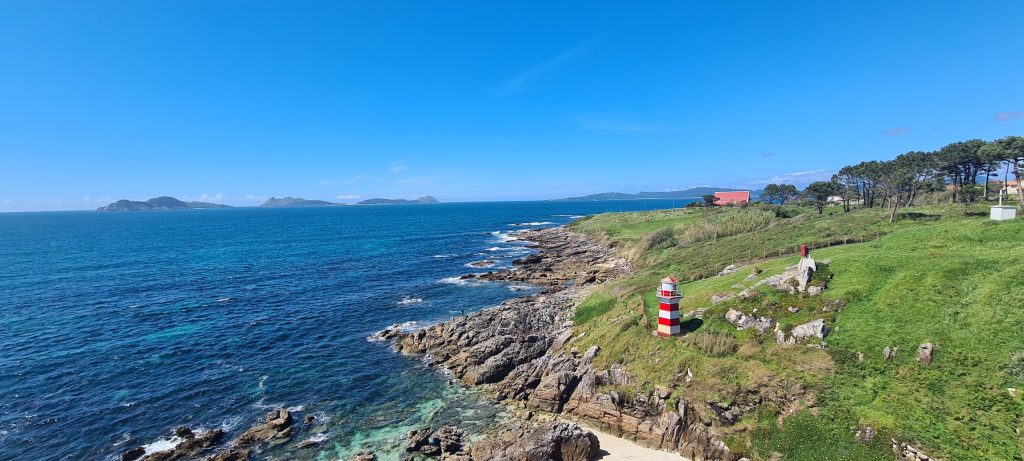
The Centro Oceanográfico de Vigo has been conducting marine research since 1917 and is part of the IEO (Instituto Español de Oceanografía). This, in turn, was founded in 1914 and is now part of the Spanish Ministry of Science, Innovation and Universities. The IEO consists of nine centers: Madrid (headquarters), Vigo, A Coruña, Cádiz, Málaga, Gijón, Murcia, Palma de Mallorca, and Santa Cruz de Tenerife. The research conducted at the Centro Oceanográfico de Vigo supports government advice and focuses on three core areas: aquaculture, marine and environmental protection, and fisheries.
Here, we will also investigate a current but little-researched environmental topic: How does artificial light at night (ALAN) affect the growth of epiphytes on macroalgae? Our experiment will take place directly at the coast, where urban light and natural darkness collide—an exciting setting for a question whose relevance grows with every illuminated city.
But why light – and why at night? Artificial light has become an integral part of our everyday lives. This is especially true along the coasts – where cities are growing, streetlights illuminate the night sky, and industrial plants operate around the clock. A look at satellite images of the Earth at night clearly shows it: Our coasts are glowing. And with each year, there are more lights – and they are getting brighter.
The impact of this constant lighting is well documented scientifically. ALAN – Artificial Light at Night – disrupts our natural day-night rhythms and influences the behaviour of numerous animal species. A classic example: newly hatched sea turtles. Instead of being guided by the moonlight towards the ocean, they often follow streetlights – and thus fatally end up on roads instead of in the water. Other species, however, seem to benefit from nighttime lighting: Certain sharks hunt more successfully under artificial light, because their prey is easier to spot.
And us humans? We, too, feel the effects. Not just through studies, but through personal experience. During our first few weeks in Vigo, there was a widespread power outage – across Spain, Portugal, and parts of France. It was 12:30 p.m. – and without a generator, suddenly nothing worked. Metro stations came to a standstill, traffic lights failed, and supermarkets could no longer refrigerate frozen goods. And at night? Suddenly, it was – really – dark. An event that made us reflect and reminded us once again how important light is—and how much we take it for granted. As beautiful as the starry sky above Vigo was that evening, the total darkness felt almost surreal. For us, it was an unusual experience—but for many organisms, this natural darkness is vital and is becoming increasingly rare. What seemed like an exception to us is a disappearing norm for a lot of animals and plants.
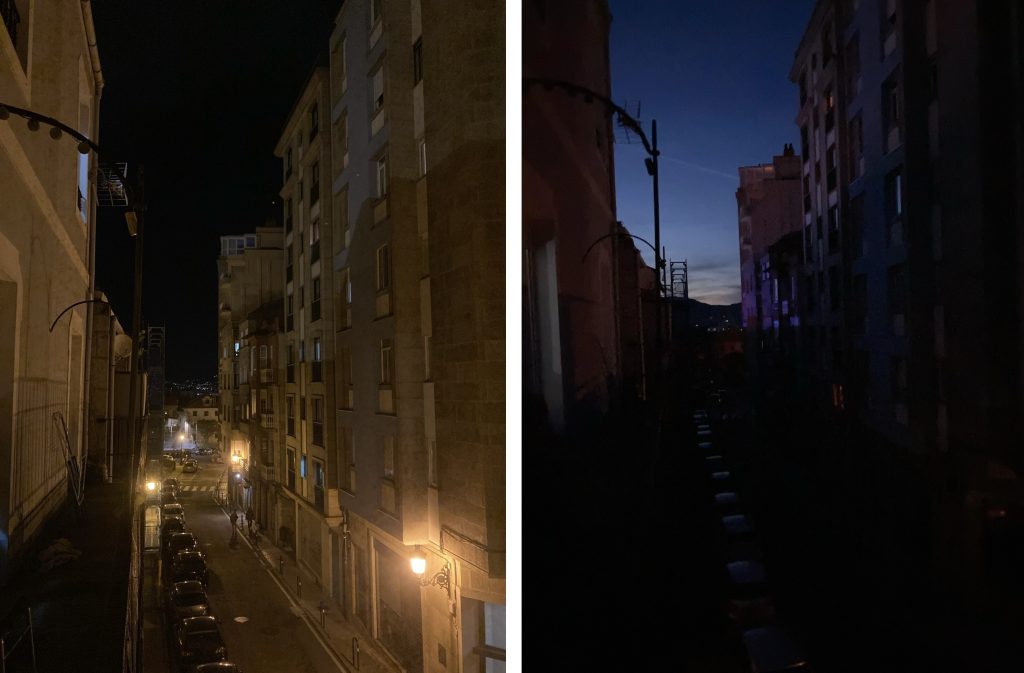
Species that are not so charismatic are quickly forgotten in this context. For example, the inconspicuous epiphytes – small growing photoautotropic organisms like unicellular microalgae or small filamentous macroalgae that colonize larger macroalgae and other solid surfaces. They make significant contributions to the services of marine benthic ecosystems by binding CO₂, stabilizing communities and providing food. At the same time, they also impair the performance of their hosts by reducing their access to light, CO2 and nutrients. Hence, a change in their abundances can have far-reaching consequences for benthic ecosystems. Yet, little is known about how they respond to artificial light at night.
There was already a GAME project in Vigo during which field experiments were conducted, but with a different scientific focus for which artificial light at night was not relevant. They were situated at the same location for which we had also received approval. Thus, we were relatively quickly confronted with the first hurdles in scientific field research – which many people don’t even realize!
The problem is that Marina Davila is located directly next to an industrial port, or rather, a large car transfer point, which is illuminated all night long with gigantic lights. It’s probably the brightest place in all of Galicia. Bad for our experimental control group, which was supposed to be in complete darkness at night. So, we spent the first week wandering around various harbor areas in the area at night, measuring the background illumination in order to find a better place for our experiments.
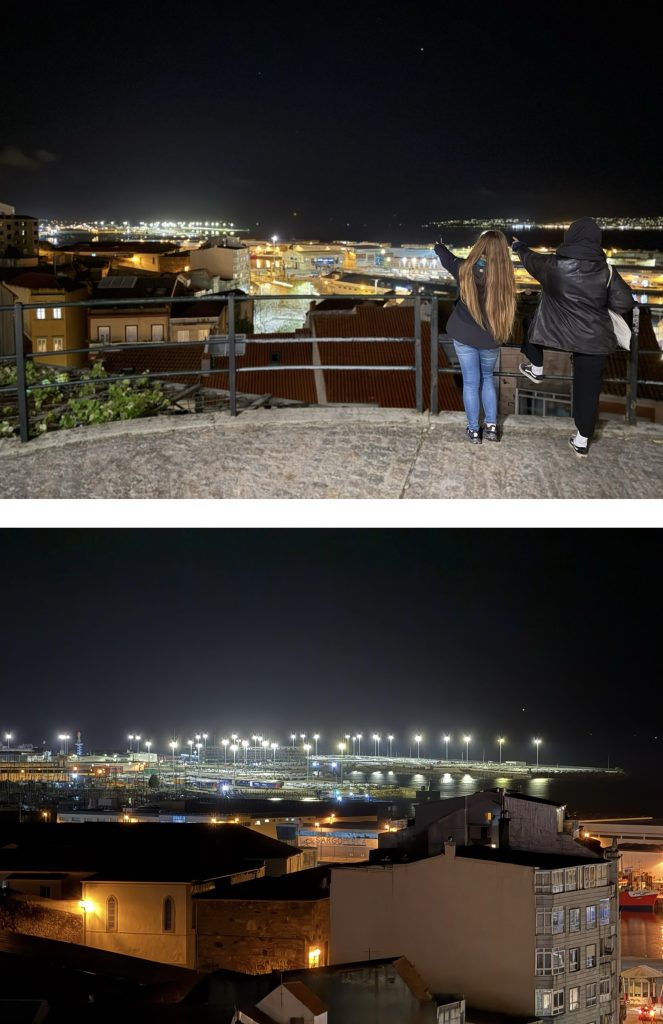
Fig. 10: Where was our study site supposed to be? We can show you! Right there (upper picture)! The brightest spot in the port. At a closer look all the cars that will be transported around the world are visible as well (lower picture). Photo: Anna 2025.
Thanks to the friendly harbourmaster at Marina Davila, we found a darker spot with even less wave exposure. However, we’re dealing with a tidal range of 4 meters, which could be tricky and is something we should keep in mind while planning our experimental setup.
Great! That was the first trick – and the second will follow quick.

Next, we need to find a suitable algae species and conduct initial trials – so-called pilot studies. This will allow us to determine the best options for our location and get a feel for the handling of the organisms, materials, and analytical methods.
Eva supports us wherever she can. As part of her own research, which focuses on plastic pollution in the ocean, we are able to accompany her one morning to the rocky bay near the institute. We were able to find different species of algae and marine organisms at low tide and also collect potential macroalgae for our project. However, the two more common Laminaria species here – Laminaria hyperborea or Laminaria ochroleuca – are difficult to distinguish from each other at a young age.
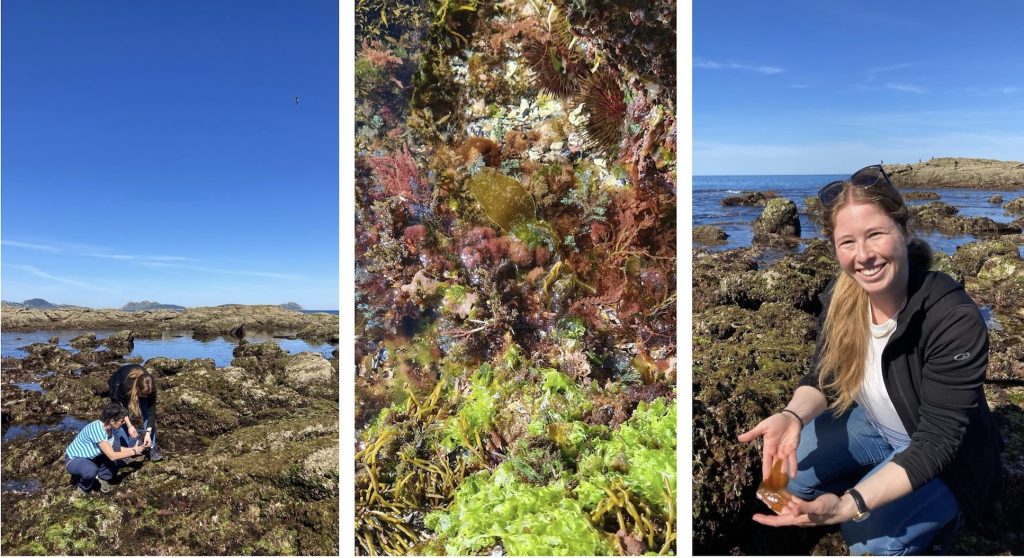
These were deployed the next day, along with other algae fragments, at our harbour site in a preliminary test. Now we just have to keep our fingers crossed that our setup holds and that it doesn’t get washed away… or even eaten by fish or invertebrate grazers.
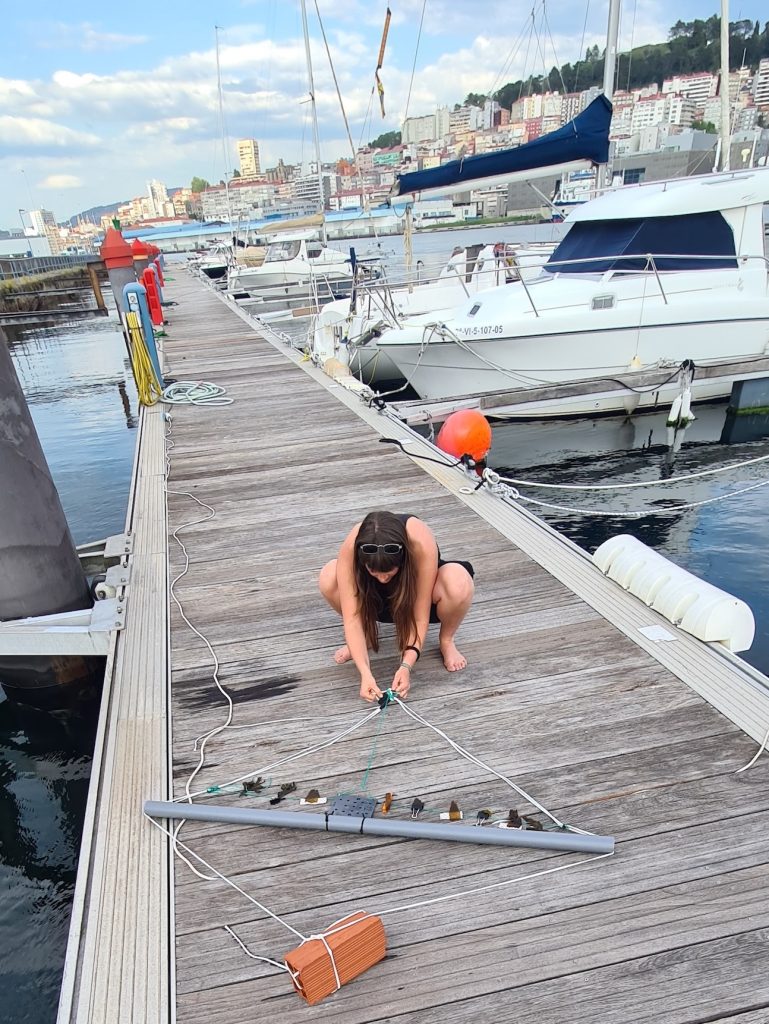
So, everything remains exciting.
In any case, we’re ready to diligently tinker and by this solve any problems that arise in the coming weeks.
Anna & Verena
Ocean Acidification
Does Eating Plastics Really Kill Ocean Animals?
The ocean has long been the end of the pipe for plastic pollution, with ocean wildlife bearing the brunt of the overproduction and overconsumption of single-use plastics. The world now produces more plastics than at any point in history—hundreds of millions of tons each year—and more than 11 million metric tons are flowing into the ocean annually. That is equivalent to more than a garbage truck’s worth of plastics entering our ocean every minute.
How does plastic kill ocean animals?
When swallowed, these plastics can be deadly—causing blockages, twisting organs or even puncturing organ walls. Ingested plastics have been found in nearly 1,300 ocean animal species, including every family of mammals and seabirds, and all seven species of sea turtles. Concern about the ecological implications of plastic-induced death rates has fueled calls for policy solutions at every level of government, from the local to the international. However, it is hard to set policy goals without understanding the measurable risk plastic ingestion poses to these species.
Ocean Conservancy scientists, along with top researchers at the University of Toronto, Federal University of Alagoas in Brazil and the University of Tazmania, worked together to answer the question: how much plastic is too much? They sought to determine how much ingested plastic is likely to cause death in seabirds, sea turtles and marine mammals. In other words, we sought to figure out the actual number of pieces and volume of macroplastics (plastics greater than 5 milimeters) that those animals must have in their gut to cause death 90% of the time.
Get Ocean Updates in Your Inbox
Sign up with your email and never miss an update.
How much ingested plastic does it take to kill an ocean animal?
We compiled data from more than 10,000 necropsies—animal autopsies—of seabirds, sea turtles and marine mammals collected between the years 1900 and 2023 where we knew both the cause of death and whether and how much plastic the animal had eaten.
The results were alarming. We were surprised by the very small amount of plastic it takes to kill a seabird. We found that rubber (the kind balloons are made from) is the deadliest form of plastic to seabirds when ingested. It only takes six small pieces of rubber—each, on average, smaller than a pea in size—to kill a seabird.
Sea turtles are also surprisingly vulnerable, given their massive size: Less than half a baseball’s worth of plastics is likely to kill one in two Loggerhead turtles. Shockingly, nearly half of all sea turtles in our database had plastics in their guts at their time of death, which is especially troubling when you consider that five of the world’s seven sea turtle species are International Union for the Conservation of Nature (IUCN) red-listed as threatened.
Our models found that marine mammals are especially vulnerable to the impacts of lost fishing debris, also known as ghost gear; when swallowed, with just 28 pieces—each smaller than a tennis ball—enough to kill a sperm whale. Additional key findings from our research for each of the animal groups we studied include:
- Seabirds
- About 35% of seabirds in our dataset had plastic in their digestive tracts.
- Roughly 5% of seabirds who had plastics in them died specifically from plastic ingestion.
- Hard plastics were consumed more frequently than all other material types, followed by soft plastics, fishing debris, rubber and foams.
- When a seabird consumes only three pieces of rubber, like balloon shreds, our models predict there is a 50% chance this consumption will lead to the animal’s death.
- Marine Mammals
- In marine mammals, fishing debris was the most frequently ingested plastic material, followed by soft plastics, rubber, hard plastics, foam and cloth.
- Roughly 12% of marine mammals in our dataset had plastic in their digestive tracts.
- Nearly 6% of marine mammals from our dataset with plastics inside died as a result of eating those plastics.
- When a marine mammal consumes just 12 pieces of soft plastic—like grocery bags—our models predict a 50% chance this action will lead to the animal’s death.
- Half a soccerball’s worth of soft plastic (by volume) is enough to kill 90% of individuals in most seal, sea lion, dolphin and porpoise species.
- Sea Turtles
- In sea turtles, soft plastics like grocery bags were found to be the most frequently ingested plastic material, followed by fishing debris, hard plastics, foams, rubber and cloth.
- Nearly 50% of individual sea turtles in our dataset had plastic in their digestive tracts
- About 9% of turtles that ingested plastic in our dataset died as a result of eating it.
- Over 4% of all turtles in our dataset died directly from plastic ingestion.
- Just 1.5 golf ball’s worth of plastic (by volume) is enough to kill 50% of adult loggerhead sea turtles.
What can this research do?
This research emphasizes the risks macroplastic pollution poses to the life of marine animals, and the risk varies by species and plastic type. Our findings provide key insights to inform future research and policy actions aimed at reducing plastic pollution and the harm it causes to ocean wildlife and ecosystems. These results also underscore that important interventions like beach cleanups and better management of plastic waste are critical for protecting marine species. Because some types of plastics are deadlier than others when swallowed by marine life, policies targeting those specific items (e.g., plastic bags and balloons) can play an important role in protecting vulnerable species from the harms of plastic pollution in the future.
It is imperative to tackle the global plastics crisis by taking actions at all levels, from local to federal to international. In the U.S., bills like the REUSE Act—bipartisan legislation that would require examination and enhancement of existing reuse and refill systems—is just one way to make a difference. Add your name now and call on lawmakers to support and pass the REUSE Act.
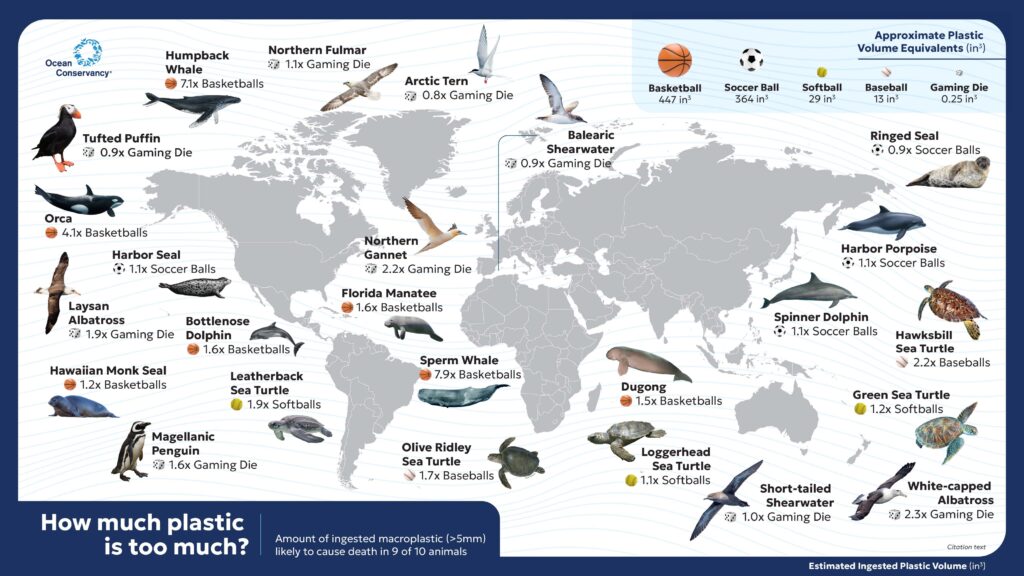
The post Does Eating Plastics Really Kill Ocean Animals? appeared first on Ocean Conservancy.
Ocean Acidification
FYORD Travel Grant Reports: November 2025
From DAAD Summer School to Doctorate: Reflections at ICON 9
Hi! I am Riel Carlo O. Ingeniero from the Chemical Oceanography Department at GEOMAR. I recently had the opportunity to attend ICON 9 (International Conference on Nitrification and Related Processes) last July 2025, one of the leading conferences focused on advances in the nitrogen cycle. It was an honour to be selected to present my research twice – first during the Early Career Workshop on the opening day, and then through a poster presentation on the second day of the main conference.
ICON 9 brought together many of the most prominent names in marine nitrogen cycle research. I was fortunate to meet and engage with inspiring scientists, including Dr. Boran Kartal, Dr. Hanna Marchant from the Max Planck Institute in Bremen, Dr. Claudia Frey from the University of Vienna, Dr. Scott Wankel from Woods Hole Oceanographic Institution, Dr. Bo Thamdrup from the University of Southern Denmark, and Dr. Qixing Ji from HKUST. I also had the chance to see Dr. Bess Ward in person, someone whose work I’ve long admired.

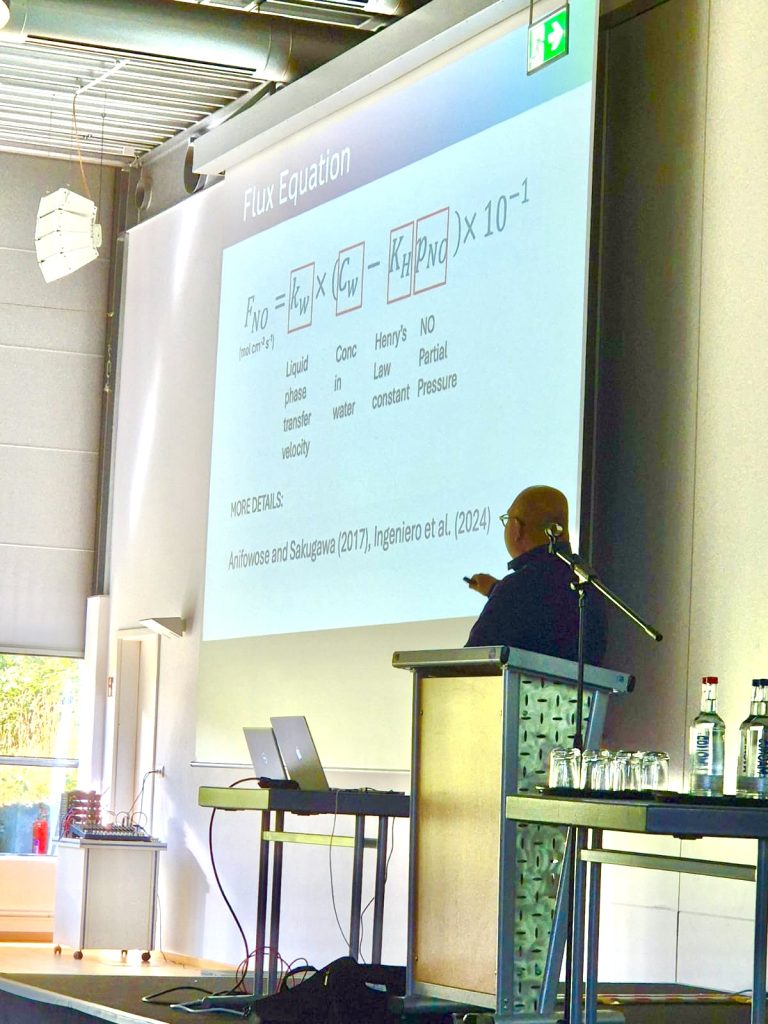
The conference was hosted by the Max Planck Institute for Marine Microbiology in Bremen, a place that holds deep personal significance. I first visited it 13 years ago during a DAAD International Summer School Biodiversity: Diversity of Ecosystems, Genes, and Species at the University of Osnabrück. That visit, including a tour of the Max Planck Institute and MARUM led by Prof. Dr. Rudolf Amann, played a pivotal role in my decision to pursue a career in marine science.
I recently completed my doctorate at Kiel University in June this year, and I am incredibly grateful for the excellent education and world-class research environment that Germany offers. Under the supervision of Prof. Dr. Hermann W. Bange and funded by the DAAD Research Grants – Doctoral Programmes in Germany and the SO305-BIOCAT-IIOE2 project, I have had the opportunity to work on cutting-edge research in marine biogeochemistry, with a particular focus on nitric oxide (NO) dynamics in the ocean.
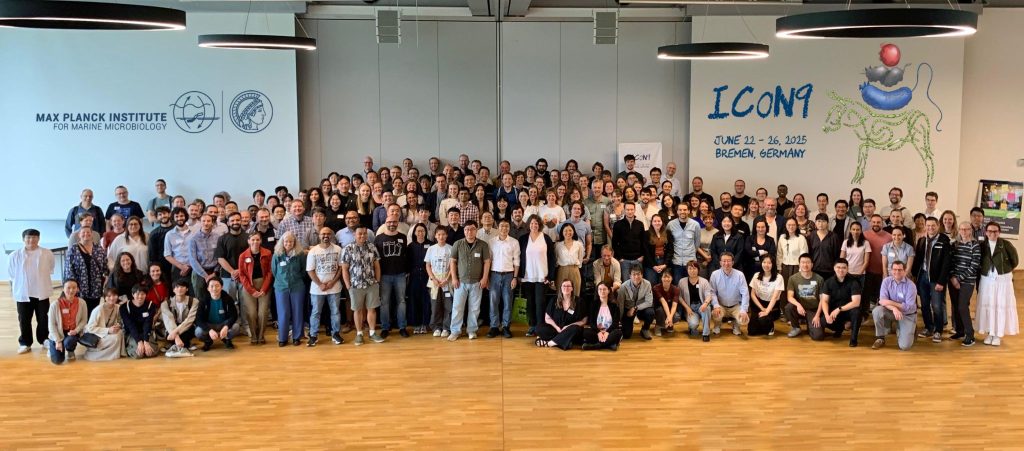
Presenting in front of over 100 participants during the ICON 9 was not only a rewarding experience but also excellent preparation just days before my doctoral defense and oral examination. Overall, ICON 9 was a meaningful and inspiring milestone, a full-circle moment in my scientific career.
Special thanks to FYORD and Kiel Marine Science for supporting my growth as an early-career marine scientist.
Riel Carlo
15th International Conference on Palaeoceanography, India
When my Uber wound through the chaotic traffic of Bengaluru at 2 am, I knew this conference would be different from the ones I was used to in Germany. I had just arrived in India for the 15th International Conference on Palaeoceanography (ICP15), supported by the FYORD Travel Grant, and was about to spend a week combining science with new cultural impressions.
ICP is a conference with a unique size and structure. It takes place only every three years, and everyone in the field is looking forward to the meeting – indeed, it rather feels more like a “big get-together” than a conference. The program is linear, with one topic per day and no parallel sessions. This allows for focus and provides more room for discussions. I also had the feeling that this format is more comfortable for Early Career Scientists. You don´t have to plan a lot in advance, and you never feel like you´re missing out on anything. But perhaps the best way to capture the spirit of ICP is to take you on a walk through a typical day:
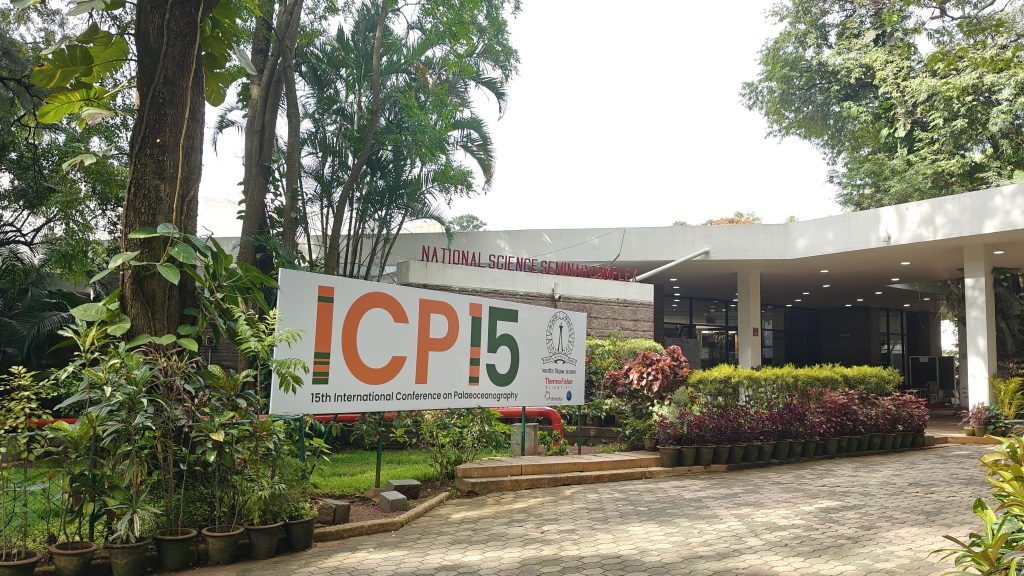
The days started with a short ride in one of the green-yellow tuk-tuks to the conference venue, which was located in one of the few green spots of the city on the campus of the Indian Institute of Science. The mornings were covered by talks by invited speakers. Actually all talks at ICP are only given by invited speakers, and you can only be selected for a talk once in a lifetime! Accordingly, we were able to enjoy some excellent presentations. Before lunch, there was a long plenum discussion with the five speakers from the morning. It was not only a great opportunity to hear different opinions on specific sub-topics, but also to show the connections between different talks, highlighting the most urgent research topics and gaps different groups are currently working on.
During lunch break, we could choose between a variety of typical Indian foods. Even though the chefs took care that the food was not too spicy for the foreign wimps, you never knew if you would sweat after the next bite. The highlight was definitely the daily Dosa, a South Indian speciality: It´s a thin, savory and crispy fried pancake made from fermented dough served with chutneys and sambars.
Long poster-sessions took place in the afternoons. All posters were put up during the whole week, which is also a big difference from huge conferences, where you usually just have a slot of one day or a few hours. It was enough time to look at the other posters, get inspired and exchange ideas. I also presented a poster with the results of the first two years of my PhD, in which I investigate climatically controlled changes in sedimentation at a site in the Southern Ocean close to Antarctica. We were able to link these changes on glacial-interglacial time scales with the ocean circulation and gain insights into the evolution of deep-water formation during times of rapid warming. Onall days, I had fruitful discussions about my work with experts in the field.

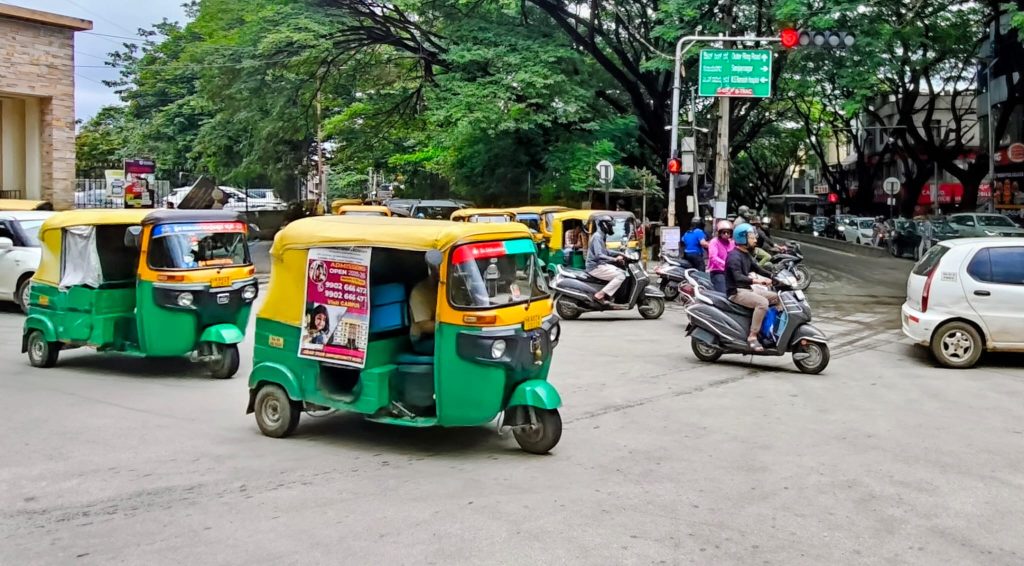
Each day was concluded with a perspective lecture by leading scientists fromthe different fields. These lectures were inspiring and an amazing summary, as they provided a broader context and deep insights into challenges and directions of palaeoceanographic research.
With the end of the scientific program, networking was not over yet, but had just started. The evenings offered a great opportunity to approach people and get into contact in a casual atmosphere. Whether at the icebreaker, conference banquet or at the Palaeomusicology Concert – another ICP tradition, which goes back to Nicholas Shackleton, paleoceanographer and skilled clarinet player. It´s an evening where the musical ones among the scientists show their skills. Singing, bagpipes, and even a small spontaneously formed band made the evening unforgettable!
Looking back, I am grateful for the opportunity to attend ICP15 with the support of the FYORD Travel Grant. It was both a scientific and cultural experience, and a great chance to meet old and new friends and colleagues. I can highly recommend ICP to other early career researchers in the field due to its unique format and special atmosphere!
Moritz
Gordon Research Conference in Animal-Microbe Interactions
My name is Igor Duarte, and I am a third-year PhD student at the Marine Symbiosis Lab, where we explore the origins and molecular novelties of close associations between bacteria and marine animals. The partnership I am mostly focused on in my PhD is between a free-living, mouthless flatworm from the genus Paracatenula, and the chemosynthetic bacteria from the genus Candidatus Riegeria that live inside its cells. In this system where no mouth is present to let nutrients in, the bacteria and are chemosynthetic, which means. After hundreds of millions of years of coevolution, this highly specialised symbiosis is now the only way by which each of these organisms can survive, and a topic of high interest to understand the evolution of such longstanding partnerships.
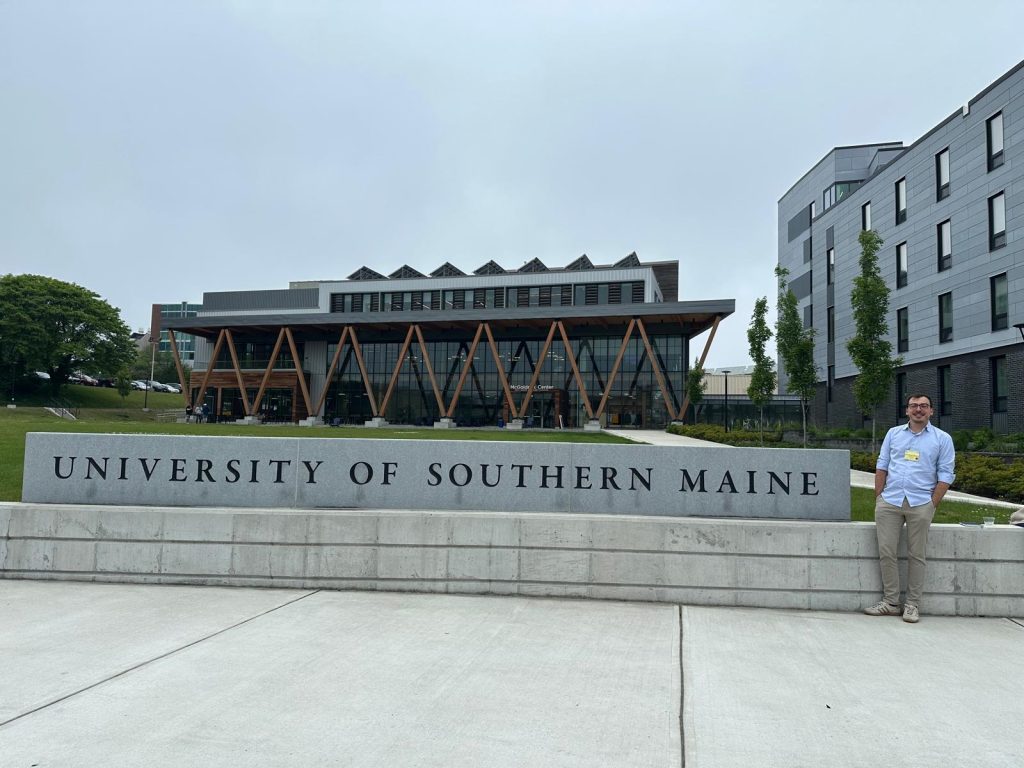
The FYORD Travel Grant programme supported my participation in the Gordon Research Conference (GRC) in Animal-Microbe Interactions, which this year took place in Portland, Maine, USA. Throughout the five days of the Conference, about 180 attendees from all over the world shared their main findings from the field of symbiosis, including the topics microbiome, intracellular microorganisms, parasitism, and evolution and molecular novelties of symbiotic associations. Additionally, the event was combined with a Gordon Research Seminar, which allowed early-career researchers to network more freely and exchange experiences from each one’s PhD and postdoctoral trajectories. I had the opportunity to present a poster entitled “Clade-specific genome evolution of Ca. Riegeria, the obligatory endosymbiont of a mouthless flatworm”, where I summarised the latest results from my PhD project.
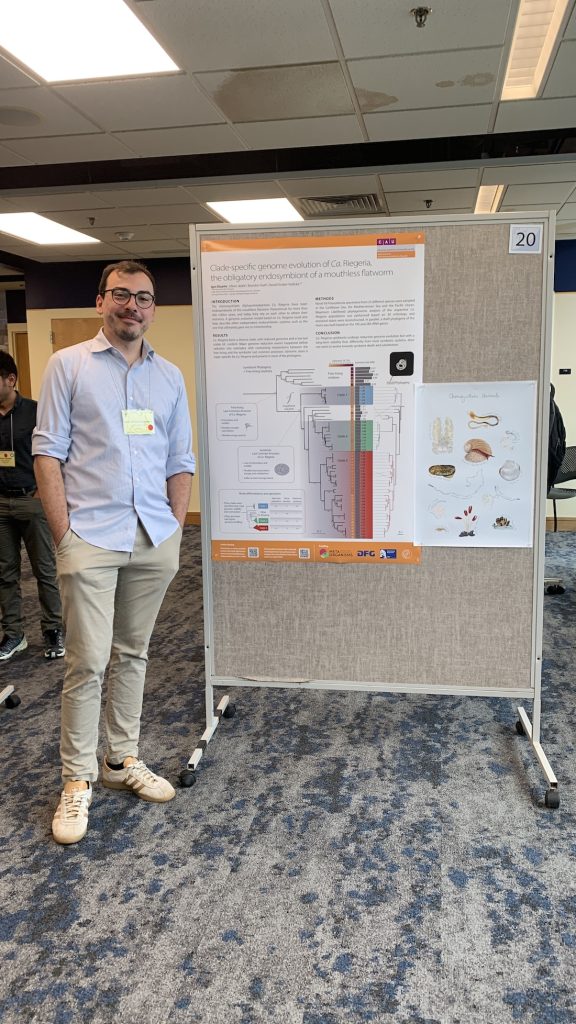
What I liked most about participating in this conference was how nicely it was conceptualised, with the goal of creating a relaxed environment to foster relevant connections between new and veteran attendees. In such a set-up, not only was I introduced to cutting-edge methods which are being used to answer relevant questions from the field, but I also had the opportunity to discuss them directly with the authors. Another positive aspect was that the speakers were encouraged to share problems that they faced during their experiments to show what real science looks like and to showcase how such issues can be overcome. Overall, I believe the conference was a game-changer for my PhD as I could get to know the main researchers in the field, whom I had so far only read about, and build the feeling of being part of a diverse community of symbiosis-enthusiasts.
Igor
Ocean Acidification
Drifting in the Post-PhD Current
Delivering
Five years into my PhD and I still wasn’t done. To be fair, I hadn’t exactly had an easy ride, starting just weeks before COVID lockdowns were announced, becoming a mother in my second year, and trying to build a new model system from scratch (Pipefish and their male pregnancy are adorable, but they don’t always make life easy). My work was trial and error, and it took me more than a year just to find a story worth telling. But eventually, the words came together. I had a draft for my first chapter. It was written! Only… was it enough? Basic research with no direct application, no flashy headline — just curiosity-driven science. Many of us know that creeping voice: does this even matter?
So, instead of calling it finished, I dove into one more dataset. In a rush of determination, I moved back into my old childhood bedroom at my parents’ house, spending days and nights analysing, writing, rewriting. By mid-November I had a plan: “Done by Christmas.”
Of course, life had other ideas. A hand surgery in between (note to future PhDs: don’t do that with a deadline). But somehow, even with one hand and one finger sticking out of a cast, I wrote. Introduction. Synthesis. Outlook. Acknowledgements.
By Christmas I wasn’t done, but close. My mother stepped in to take care of my daughter while I revised paragraph after paragraph under the Christmas tree. And then, in early January 2025, the moment came: university reopened, I submitted my dissertation, and it was gone. Done. Crazy. For two days, I let myself breathe and celebrate. Then reality hit: only six weeks until my defence.
Defending
Days passed and my defence presentation kept growing. Twenty slides, then thirty, then sixty. Every time I thought it was enough, I added more — extra data, backup information. Not because I wanted to show it all, but because I wanted to be ready for those tough questions. At the same time, I knew this wasn’t just about surviving the defence. I wanted to celebrate it. I booked a big conference room, reserved a restaurant table, and sent out invitations. And suddenly it felt real: my family travelling in from far away, a friend making the trip from abroad, old classmates and colleagues all saying yes. That was overwhelming in the best way. Practising my talk became part of my daily routine. Alone in my office and in front of colleagues or friends. I have to admit: I’ve always liked presenting more than drowning in raw data, so this part was actually… fun.
The morning of the defence, I woke up to an email that made my heart stop: Water pipe leakage at university. All buildings evacuated. No exams allowed. Seriously? After weeks of preparing, was it all about to fall apart? What I hadn’t expected was the incredible support around me. Within minutes, my PI had secured a new venue. Huge shout-out to the Marine Science Campus for stepping in and hosting me! And somehow, despite the last-minute chaos, everyone showed up.
During the defence itself, my brain switched to autopilot. Over forty pairs of eyes were on me, waiting for me to present and defend five years of work. The questions that followed were tough and sometimes tricky, but also sparked real conversations. Ninety minutes passed in a blur. Then it was done. I was done. A doctor of natural sciences – me? Hell yeah. The rest of the day was exactly what I had dreamed of: celebrating, telling stories, reliving the journey with the people who had been part of it. Finally enjoying this thing, I had worked toward for over five years. Relief and happiness like I had never felt before. And, as the cherry on top, I got the nicest doctoral hat that I could have imagined – with a glowing giant microbe and two crocheted guinea pigs perched proudly on top.

Drifting
The night of my defence, I went to bed expecting to wake up reborn – full of joy, energy, freedom. Instead, I woke up tired. Deeply tired. And strangely quiet inside. There was still paperwork to finish before I could officially call myself a doctor, and manuscripts waiting for submission. But the constant pressure, the expectations, the dependence on PIs, the weight of proving myself worthy of a title that even shows up in your passport, was suddenly gone. In its place came exhaustion, but also a growing sense of lightness. I gave myself a week to move slowly: sleeping, recharging, joining a retreat with my colleagues. Bit by bit, relief started to settle in. I really made it.
And the moment it truly sank in wasn’t the defence or the party, but a few weeks later. Walking out of the administration building at Kiel University with my PhD certificate in hand – that was the moment it felt real.
Kim
-
Climate Change4 months ago
Guest post: Why China is still building new coal – and when it might stop
-
Greenhouse Gases4 months ago
Guest post: Why China is still building new coal – and when it might stop
-
Climate Change2 years ago
Spanish-language misinformation on renewable energy spreads online, report shows
-

 Greenhouse Gases2 years ago
Greenhouse Gases2 years ago嘉宾来稿:满足中国增长的用电需求 光伏加储能“比新建煤电更实惠”
-
Climate Change Videos2 years ago
The toxic gas flares fuelling Nigeria’s climate change – BBC News
-

 Climate Change2 years ago
Climate Change2 years ago嘉宾来稿:满足中国增长的用电需求 光伏加储能“比新建煤电更实惠”
-

 Carbon Footprint2 years ago
Carbon Footprint2 years agoUS SEC’s Climate Disclosure Rules Spur Renewed Interest in Carbon Credits
-
Renewable Energy5 months ago
US Grid Strain, Possible Allete Sale



